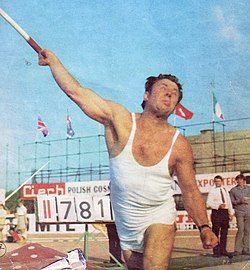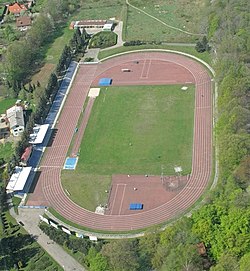Polish Athletics Championships
 From Wikipedia - Reading time: 12 min
From Wikipedia - Reading time: 12 min
| Current season, competition or edition: | |
 | |
| Sport | Athletics |
|---|---|
| Founded | 1920 |
| Country | Poland |
The Polish Athletics Championships (Polish: Mistrzostwa Polski seniorów w lekkoatletyce) is an annual outdoor track and field competition organised by the Polish Athletic Association (PZLA), which serves as the Polish national championship for the sport. It is typically held as a three-day event in the Polish summer, ranging from late June to early August. The venue of the championships changes annually.
Following the establishment of the PZLA in 1919, the national championships was first held in 1920 as a men-only event. The first two championships were held in Lviv (now in Ukraine) as this city was the headquarters of the national sports body and home to the only modern athletics stadium in the country.[1] Women's events were included shortly after in 1922.[2] The women's championships were contested separately from the men's from 1925 to 1949 (1945–46 excepted). The championships has been contested every year since its inception, bar a brief period from 1940 to 1944 when World War II led to abandonment of the competition.
Events
[edit]The current track and field programme features a total of 40 individual Polish Championship athletics events, divided evenly between the sexes.
- Track running
- Obstacle events
- 100 metres hurdles (women only), 110 metres hurdles (men only), 400 metres hurdles, 3000 metres steeplechase
- Jumping events
- Throwing events
- Combined events
- Decathlon (men only), heptathlon (women only)
The competition has featured more unusual events, such as the grenade throw for men in 1951 and both men and women in 1952. Men competed in the standing long jump at the 1920 and 1921 editions. This event had a longer history in the women's programme, lasting from 1927 to 1947. A men's 200 metres hurdles was first contested in1 1953 but stopped after 1963. Women contested that event in 1970 and 1971. A few events were unique to women, including the 60 metres (held from 1922 to 1950), a 250 m (1924 to 1926), a 1000 m in 1926 and 1927, and a 500 m from 1949 to 1951.[3]
The women's programme expanded inline with international acceptance of women's athletics. The women's 1500 metres was added in 1969 and the 400 m hurdles followed the year after. The women's 3000 metres was introduced in 1973 and contested up to 1994. The women's equivalents of the men's standard 5000 m and 10,000 m were added in 1984. The 80 metres hurdles was combined with the 100 metres hurdles at the 1968 championships, before the longer distance replaced it the following year. Later additions to the women's programme were triple jump (1991), pole vault and hammer throw (1995) and the steeplechase (1999).[2]
Championship events are held at different locations for combined track and field events, road running and walks, and cross country running.
Editions
[edit]








Championship records
[edit]Men
[edit]Women
[edit]See also
[edit]Notes
[edit]References
[edit]- ^ Jurek, Tomasz& Krzewiński, Ignacy & Woltmann, Bernard. Lekkoatletyka w Polsce 1919 - 1994 (1994). Polskie Towarzystwo Naukowe Kultury Fizycznej ISBN 83-900895-5-6.
- ^ a b Polish Championships. GBR Athletics. Retrieved 2018-03-23.
- ^ Henryk Kurzyński, Stefan Pietkiewicz, Janusz Rozum, Tadeusz Wołejko: Historia finałów lekkoatletycznych mistrzostw Polski 1920-2007. Konkurencje męskie. Szczecin – Warszawa: Komisja Statystyczna PZLA, 2008, s. 113. ISBN 978-83-61233-20-6.
- ^ "Bydgoszcz (Stadion Miejski) 1933m, 1937k, 1948k" (in Polish). nastadiony.pl. Retrieved 24 October 2012.
- ^ "89. Mistrzostwa Polski Seniorów" (in Polish). pzla.pl. Retrieved 7 September 2012.
- ^ "90. Mistrzostwa Polski Seniorów" (in Polish). Polski Związek Lekkiej Atletyki. Retrieved 20 September 2013.
- ^ "Kalendarz Mistrzostw Polski 2015 (projekt)" (in Polish). Polski Związek Lekkiej Atletyki. Retrieved 5 August 2014.
- ^ Maciej Jałoszyński. "Kraków gospodarzem Mistrzostw Polski Seniorów 2015" (in Polish). Polski Związek Lekkiej Atletyki. Retrieved 22 October 2014.
- ^ Maciej Jałoszyński. "Bydgoszcz, Toruń, Suwałki i Gliwice ugoszczą MP 2016" (in Polish). Polski Związek Lekkiej Atletyki. Retrieved 23 December 2015.
- ^ Maciej Jałoszyński (11 October 2016). "Białystok gospodarzem 93. Mistrzostw Polski" (in Polish). Polski Związek Lekkiej Atletyki. Retrieved 11 October 2016.
- ^ "94.PZLA Mistrzostwa Polski.Lublin, 20–22 lipca 2018" (PDF) (in Polish). pzla.pl. 2018-07-23. Retrieved 2018-07-24.
- ^ Faster wind assisted times have been recorded: Marcin Jędrusiński won the 2003 100 metres title in 10.07 seconds and Marek Zalewski ran 10.12 in 1993, but both had wind over the legal limit of 2 m/s.
- ^ Marcin Jędrusiński ran a wind-assisted 200 metres in 20.38 seconds
- ^ a b c d e "Komunikat końcowy zawodów, Białystok, 21-23 July 2017, 93. PZLA Mistrzostwa Polski" (PDF) (in Polish). Polski Związek Lekkiej Atletyki. Archived from the original (PDF) on 2 August 2017. Retrieved 26 July 2017.
- ^ "Chabowski mistrzem Polski na 10 kilometrów" (in Polish). sport.trojmiasto.pl. Retrieved 10 August 2011.
- ^ "National championships round-up: Nugent and Thompson impress in Jamaica". World Athletics. 30 June 2024. Retrieved 2 July 2024.
- ^ Wind assisted long jump marks include Marcin Starzak in 2008 (8.20 m, +3.3 m/s), as well as 8.17 m by Andrzej Klimaszewski in 1985 and 8.16 m by Stanisław Jaskułka in 1986.
- ^ In 1984, Zdzisław Hoffmann had a wind-assisted mark of 17.28 m
- ^ "Komunikat końcowy zawodów, Bydgoszcz, 24–26 June 2016; 92. Mistrzostwa Polski Seniorów" (PDF) (in Polish). Polski Związek Lekkiej Atletyki. Archived from the original (PDF) on 16 August 2016. Retrieved 26 July 2017.
- ^ "Rafał Augustyn mistrzem Polski na 50 km" (in Polish). pzla.pl. Retrieved 31 March 2015.
- ^ "National championships round-up: Nugent and Thompson impress in Jamaica". World Athletics. 30 June 2024. Retrieved 2 July 2024.
- ^ "Lewandowska pierwszą mistrzynią Polski" (in Polish). Polski Związek Lekkiej Atletyki. Retrieved 27 May 2012.
- ^ This record was matched by Lucyna Langer-Kałek at the 1982 Polish Championships.
- Records
- Henryk Kurzyński, Stefan Pietkiewicz, Janusz Rozum, Tadeusz Wołejko: Historia finałów lekkoatletycznych mistrzostw Polski 1920–2007. Konkurencje męskie. Szczecin - Warszawa: Komisja Statystyczna PZLA, 2008. ISBN 978-83-61233-20-6.
External links
[edit]- Polish Athletics Association website (in Polish)
 KSF
KSF